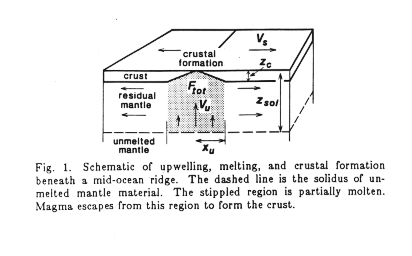
(Figure 7-1, from (17))
Melt that reaches the crust has its origin in the mantle, with melting occurring as ascending mantle material adiabatically decompresses. In this model
Eq 7-1:![]()
![]()
Eq 7-2:![]()

The simplest model for mantle convection involves a diverging plate overlying
a semi-infinite medium of constant viscosity. This model predicts that V![]() ~V
~V![]() .
Thus the zone of upwelling is predicted to be rather wide, about 30 km.
One of the central issues in contemporary studies of mantle circulation
and its relationship to crustal construction is how to focus the melt from
this wide zone of melting into a narrow zone of volcanism.
.
Thus the zone of upwelling is predicted to be rather wide, about 30 km.
One of the central issues in contemporary studies of mantle circulation
and its relationship to crustal construction is how to focus the melt from
this wide zone of melting into a narrow zone of volcanism.
To understand the parameter zsol, we can examine the relationship of an adiabat to the solidus for mantle rock. As a function of temperature and pressure:
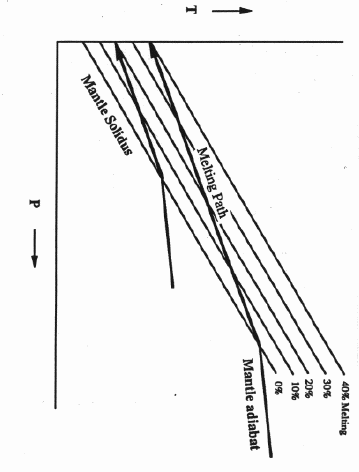
Figure 7-2, from (18))
The solidus for mantle material has a slope of about 12°C/kbar while an adibat in the mantle has a slope of about 1°C/kbar, hence these eventually cross and melting begins. Once within the field of melting, the effect of the negative heat of melting is to cause the temperature decrease with decreasing pressure to be steeper than the adiabat. The temperature of the mantle controls both the depth at which melting begins and the fraction of melt generated.
These thermodynamic relationships can be superimposed on the physical model:
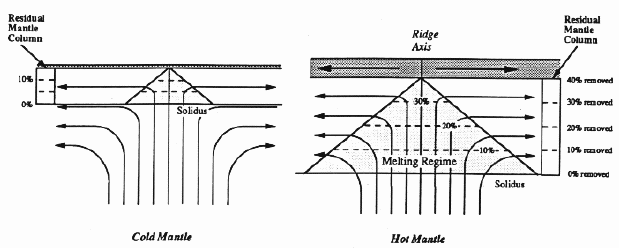
Figure 7-3, from (18))
When the mantle is cold, melting is initiated at shallower depth and over a narrower zone. A thin crust is generated and the depletion in the residual mantle is minimal. When the mantle is hot, melting is initiated at greater depth and over a wider zone. A thick crust is created and there are greater chemical changes in the residual mantle which extend to greater depth.
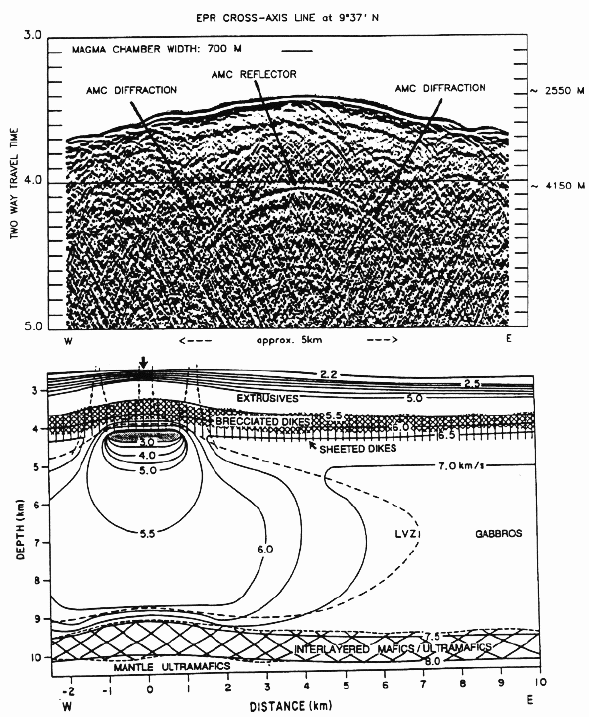
Figure 7-4, from (19))
This is thought to be a steady state feature, found on 60% of the ridge between the Siqueiros Fracture Zone at 8°30'N and 13°30'N. Its width across axis is 1-1.5 km and height 100-500 m. The low velocity zone surrounding this body is thought to be material with at least 3% melt. In contrast there is no evidence of the existence of persistent magma chambers on the Mid-Atlantic Ridge, although such bodies are likely present episodically.
We can sketch the scales involved:
![[large scale geometry]](f20-1.gif)
Figure 10-1
The basaltic crust is emplaced as melt in a narrow zone at the ridge axis, at a temperature near 1300 °C. At the ridge axis, high temperature circulation of fluid is established, with fluid temperatures reaching 350-400 °C. Thus as the crust leaves the zone of generation, it is cooler than it would be by conduction alone. As we will see, a reasonable estimate of the mean temperature of the crust a few kilometers off axis is 200 °C. Thus on a time scale of 100 ky (5 km distance with 5 cm/y spreading), the melt has both solidified and cooled considerably. The heat to be lost in this zone includes both the latent heat of crystallization of the melt and the cooling of the solid rock mass, so that the total heat loss is:
Eq 10-1:![]()

On a global scale, the
rate at which ocean crust is generated is 5.4 x 10![]()
![]() g/y so
the convected heat is about 2.3 x 10
g/y so
the convected heat is about 2.3 x 10![]()
![]() cal/y. This is about 1/2 the
deficit in observed conductive heat flow relative to the conductive
plate model. (Note that this calculation does not account for conductive
heat transfer in this zone.)
cal/y. This is about 1/2 the
deficit in observed conductive heat flow relative to the conductive
plate model. (Note that this calculation does not account for conductive
heat transfer in this zone.)
On a local scale, we can consider as an example the Endeavour Segment, northern Juan de Fuca Ridge on which the spacing of major sites of hydrothermal discharge is of order 2 km. The heat loss from a 2 km section of ridge should be of order 1.6 x 1015 cal/y:
(crustal depth) x (cell
spacing) x (full spreading rate) x (density) x (heat transfer)
6 km x 2 km x (2x5 cm/y) x 3 g/cm![]() x 433 cal/g
x 433 cal/g
while individual vent fields here discharge 0.6 GW = 4.5x1015 cal/y, i.e. the instantaneous flux is 3 times as great as the long term geological average. This implies that venting must be short-lived and episodic.
Magma bodies can serve as a source of heat for hydrothermal circulation. Schematically:
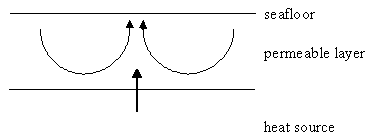
Figure 10-2
But how quickly does this molten material solidify?
| Oceanography 540 Pages Pages Maintained by Russ McDuff (mcduff@ocean.washington.edu) Copyright (©) 1994-2001 Russell E. McDuff and G. Ross Heath; Copyright Notice Content Last Modified 2/28/2001 | Page Last Built 2/28/2001 |